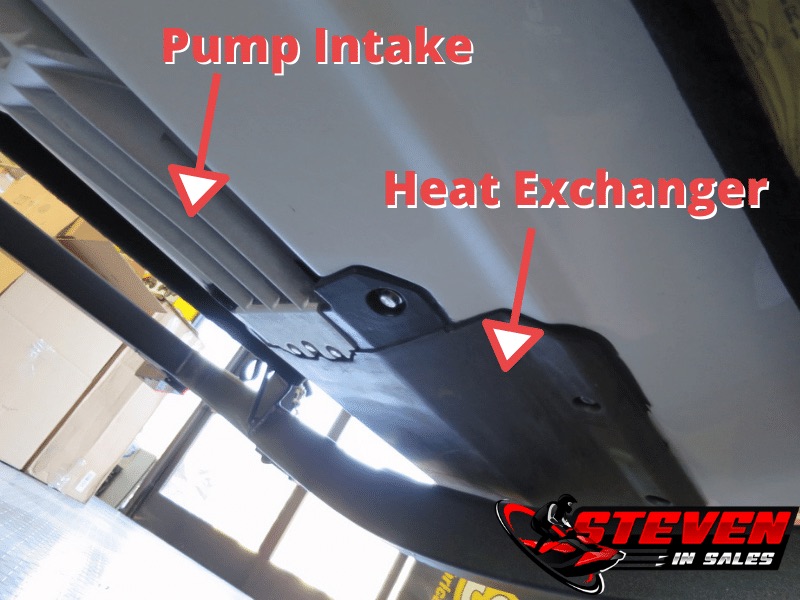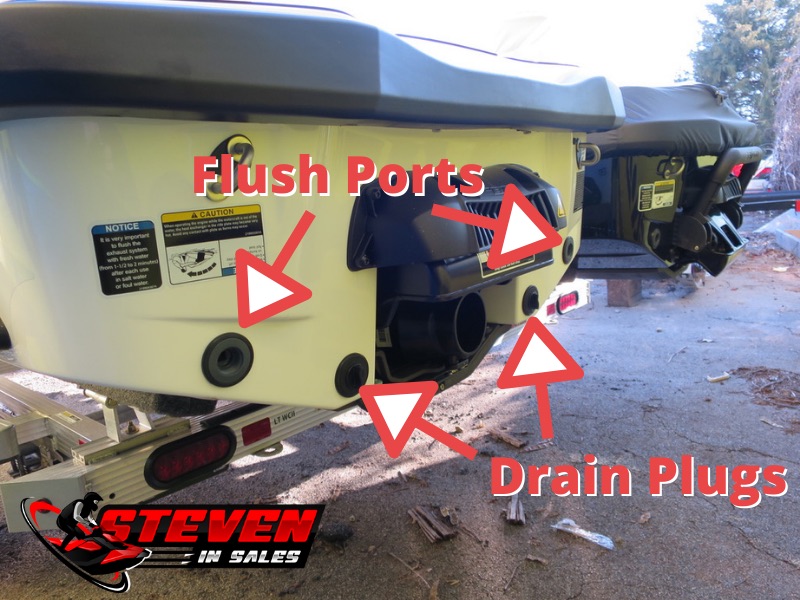Can you run a jet ski out of the water? It’s a great question for any enthusiast looking to maintain their watercraft in top condition. Drawing from my own experiences — and a few close calls — I’ve learned the importance of not running too long when not in water.
Whether it’s a quick engine test or a thorough flush after a day in saltwater, knowing the safe duration is key to preventing damage. For a typical run without water, a 15-second max rule applies to safeguard your engine!!! And when it comes to flushing your PWC connected to a water supply, keeping it under 90 seconds is your best bet. (This is mostly for Sea-Doo and their carbon seals!)
But beware, the urge to overly rev the engine, especially for Sea-Doos, should be avoided!
Ready to dive deeper into the dos and don’ts of jet ski flushing? Join me as we explore effective practices for running your watercraft when not in water, the science behind the cooling systems, and tailored advice for different jet ski models. Learn more below.
Sea-Doo Uses A different Cooling System
A Sea-Doo is very different from all the other brands of watercraft on the market when it comes to cooling the engine.
A Sea-Doo engine doesn’t use lake or ocean water to cool it down, but instead uses a heat exchanger just like your car.
Even though you have a closed loop cooling system, the Sea-Doo still can’t be run without water. This is because the exhaust system still uses lake or ocean water to keep it cool.
If you want to run the Sea-Doo for a little longer, you’ll need to hook it up to a water supply to flush it.
Flushing is important if you do a lot of saltwater riding or ride somewhere that doesn’t want water cross-contamination. Flushing is also needed if you want to winterize a waverunner, but you don’t use water and instead flush it with biodegradable anti-freeze.
How Do You Flush A Sea-Doo?
In the back of a Sea-Doo is a flush adaptor that is threaded to fit a regular garden hose.
For complete instructions, please refer to your owner’s manual. Here are the general instructions…
- Screw on the garden hose to the Sea-Doo. It doesn’t need to be tight. (It’s best that it’s not tight!)
- Turn the Sea-Doo on and let it idle for 5 seconds.
- Turn water on.
- 3 seconds later, you should see water coming from the pump and exhaust. This is how you know it’s being flushed.
- Flush it for no more than 90 seconds!!!
- Turn water supply off from the hose.
- Turn Sea-Doo off.
It’s critical that you have the watercraft on before you turn on any water and when done you turn the water off before turning the engine off. Doing it any other way can hydro-lock the engine!!!!!!!!
Video Instructions:
Some of the older Sea-Doo’s (2-strokes) require a flush adaptor.
The flushing point on a Sea-Doo will always be in the rear for 4-strokes. 4-stroke Sea-Doo’s came around in 2002 and there were only 4-strokes after 2008. Newer Sea-Doo’s flushing port is gray and easy to find on the outside, like the picture at the top of this post shows. In older 4-strokes or Sparks, the flush point is black and tucked away near the nozzle.
Yamaha, Kawasaki, And Others?
The other brands don’t use closed-loop cooling, and they do take in water to cool the engine. They can still be turned on when not in water for a few seconds also, but the entire engine and exhaust are not being cooled.
Jet skis intake water differently compared to boats, which use a spinning pump submerged in water. Instead, jet skis utilize the impeller as a pump. There is a small hole in the pump that allows water to flow through, which is used to cool the engine.
Please consult your owner’s manual for the correct procedure for operating your Yamaha, Kawasaki, and other jet skis on the hose. The instructions are very similar to the instructions for using a Sea-Doo as talked about earlier.
Video Instructions:
Many manufacturers don’t make it easy and require you to buy a flush adaptor for certain models. To make this easy, I’ve listed some options below. It’s still best to consult your owner’s manual first.
- Yamaha Flush Adaptor (Amazon Link Ad)
- Kawasaki Flush Kit (Amazon Link Ad)
Can I Run The PWC On The Hose Instead Of A Test Ride?
I need to make a note that running a watercraft on the hose is not a substitute for taking it for a test ride!
Don’t let someone selling jet skis fool you with “it runs fine on the hose” as it is not the same as running it in the actual water.
Water intake and simply being in water affects the jet ski very differently compared to running it on a water hose. I’ve had several jet skis run fine on the hose but give a different story once in water.




Why does my jet ski run fine on land but the moment it’s in the water it won’t move the jet looks clean
Since jet skis are direct drive, when you put it in the water the engine has to turn over the impeller too, which is harder to do in water than air. So you may have a weak battery, bad starter or bad connections that are just strong enough to crank the engine on land but not water.
I have a gtx 230 new
In the manual it says never flush a hot engine.
How long after using the ski is safe to flush or should youwait until completely cold ie over night
I use mine until about 7 pm
Leave standing on the water for maybe 30 mins
Recover and drive home. Maybe another 30 mins
Engine is still warm
Is it ok to flush?
Thanks
After 30 minutes, the engine is cool enough.
They don’t want you blasting around all day and then directly hooking up to the cool tap water 1 minute later; It stresses the metal too much.
Thanks for that
Very helpful
I’ve got some good info off your site.
I’m pleased that I went for a 230 rather than a 170
Thanks for your articles. They are very helpful.
I’m researching buying a used jet ski. Say the jet ski owner lives hours from a lake or the lakes are still frozen in the off-season. Is it possible to substitute a lake-test with a test hooked up to a hose (assuming all the other systems are obviously working, like steering, electrical, compression, etc)? Or is it necessary to wait until an in-water test is possible?
Obviously, an actual lake-test is preferred. I haven’t found a machine to look at yet, but I ask just in case.
Thanks
Running on the hose is not a replacement for a lake test. I’ve had several jet skis run fine on the hose but not so great when on the water. You can tell a lot about a jet ski from land but there is that 5% of things that will only show up when riding it on the water. I have a few guides on buying used jet skis that can help.
https://www.steveninsales.com/5-factors-consider-buying-used-jet-ski/
https://www.steveninsales.com/used-jet-ski-buyers-guide/
Thank you!
I’m praying I didn’t mess up too badly. I connected the hose to my jet ski and turned on the water, then tried to start it. It tried to turn over once but then it wouldn’t turn over the battery acted dead. It never would start. Did I mess it up? I am getting a new battery but hoping I didn’t damage it. The battery looks old but I’m concerned because I didn’t know you don’t run water. I figured it was similar to the boat. I have a JH900 zxi
A jet ski is not the same as a boat when it comes to hooking it up to water. From the sound of it, you hydro-locked your watercraft. Most, if not all watercraft, you have to turn the engine on first then the water. Then turn the water off then the jet ski engine off. Since there are many watercraft its best to consult the owners manual on the proper flushing procedure. If I were you I would stop trying to turn the engine on as this can bend the rods and destroy your engine. It’s best to get it to a repair shop right away and tell them what happen.
I want to buy a used ski. I have riden and gassed them, nothing more. What resources are there to guide a purchase..other than putting the ski in the water.
I’m actually working on an ebook that is a used jet ski buying guide at this very moment. The book will cover what to look for when buying used and techniques I’ve used for haggling and buying. Would this be something you would be interested in? I plan on releasing it next week. Let me know if there are any nagging questions you have about jet skis that I could answer in the book.
I would probably be interested in a buying guide. I have a boat but want to sell it and get a pair of personal watercraft. I don’t know much about them
I have a new jet ski buyers guide here https://www.steveninsales.com/new-jet-ski-buyers-guide/
Let me know if you have any more questions about jet skis.